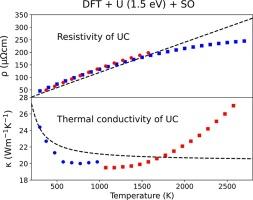The role of electron correlations and spin-orbit interaction in predicting electrical and heat transport of uranium monocarbide
IF 3.2
2区 工程技术
Q3 MATERIALS SCIENCE, MULTIDISCIPLINARY
引用次数: 0
Abstract
Electrical and heat transport in UC, a potential fuel material for generation IV nuclear reactors, is investigated within density functional theory incorporating strong local Coulomb and spin-orbit interactions. The localization of 5f electrons is tuned by varying the Coulomb repulsion interaction parameter from 0 to 3 eV. We demonstrate that both strong electron correlation and spin-orbit coupling effects are crucial for realistic modeling of the electron-phonon scattering process, which is a driving mechanism of the electrical and heat transport in UC. Partially localized 5f states, described by a moderate value of the on-site Coulomb repulsion parameter of 1.5 eV, together with spin-orbit interaction reproduce experimental resistivity and thermal conductivity in UC with exceptionally good accuracy in a wide temperature range extending from 300 to 1900 K. The present theoretical approach can potentially be used to eliminate the discrepancy between theory and experiment, as well as to predict the thermoelectric properties of other actinide-based fuel materials for modern nuclear reactors.

电子相关和自旋轨道相互作用在预测单碳化铀电输运和热输运中的作用
UC是第四代核反应堆的潜在燃料材料,在密度泛函理论中结合强局部库仑和自旋轨道相互作用研究了UC中的电和热输运。通过改变库仑斥力相互作用参数从0到3 eV来调整5f电子的局域化。我们证明了强电子相关效应和自旋轨道耦合效应对于电子-声子散射过程的真实建模至关重要,这是UC中电和热输运的驱动机制。部分局域化5f态,由1.5 eV的库仑斥力参数描述,加上自旋轨道相互作用,在300 ~ 1900 K的宽温度范围内以非常好的精度再现了UC中的实验电阻率和导热系数。目前的理论方法有可能用于消除理论与实验之间的差异,以及预测现代核反应堆中其他锕系燃料材料的热电特性。
本文章由计算机程序翻译,如有差异,请以英文原文为准。
求助全文
约1分钟内获得全文
求助全文
来源期刊

Journal of Nuclear Materials
工程技术-材料科学:综合
CiteScore
5.70
自引率
25.80%
发文量
601
审稿时长
63 days
期刊介绍:
The Journal of Nuclear Materials publishes high quality papers in materials research for nuclear applications, primarily fission reactors, fusion reactors, and similar environments including radiation areas of charged particle accelerators. Both original research and critical review papers covering experimental, theoretical, and computational aspects of either fundamental or applied nature are welcome.
The breadth of the field is such that a wide range of processes and properties in the field of materials science and engineering is of interest to the readership, spanning atom-scale processes, microstructures, thermodynamics, mechanical properties, physical properties, and corrosion, for example.
Topics covered by JNM
Fission reactor materials, including fuels, cladding, core structures, pressure vessels, coolant interactions with materials, moderator and control components, fission product behavior.
Materials aspects of the entire fuel cycle.
Materials aspects of the actinides and their compounds.
Performance of nuclear waste materials; materials aspects of the immobilization of wastes.
Fusion reactor materials, including first walls, blankets, insulators and magnets.
Neutron and charged particle radiation effects in materials, including defects, transmutations, microstructures, phase changes and macroscopic properties.
Interaction of plasmas, ion beams, electron beams and electromagnetic radiation with materials relevant to nuclear systems.
 求助内容:
求助内容: 应助结果提醒方式:
应助结果提醒方式:


